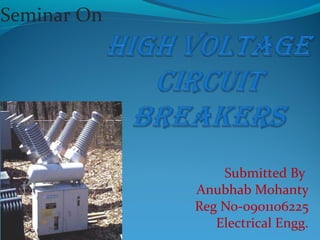
Circuit breaker
- 1. Seminar On Submitted By Anubhab Mohanty Reg No-0901106225 Electrical Engg.
- 2. Contents Introduction Operating mechanism Types of circuit breakers Air Blast circuit breaker Vacuum circuit breaker Oil circuit breaker SF6 circuit breaker Conclusion
- 3. Introduction A circuit breaker is a mechanical switching device, capable of making, carrying and breaking currents under normal circuit conditions. It is also capable of making and carrying currents for a specified time and breaking currents under specified abnormal circuit conditions, such as those of a short circuit.
- 4. Fixed Fixed contact contact ARC ARC IS ARC QUENCHED BY MEDIUM Moving Moving contact contact OPERATING PRINCIPLE OF BREAKER IN A CIRCUIT BREAKER
- 5. Operating Mechanism Circuit Breaker consists of two contacts: Fixed contact. Moving contact. Moving contact is used to make and break the circuit using stored energies in the form of spring or compressed air. Spring, pneumatic or oil damping is used to arrest the speed of mc while closing. FC contains a spring which holds the mc after closing.
- 6. Circuit breaker consists of two coils: Closing coil –Used to close the circuit. Tripping coil-Used to trip the circuit. These coils activate the stored energy and directs the mc to open or close. DC batteries are used to energize these coils. Solenoids are used to close or trip it. CBs are usually arranged with pilot devices to sense a fault current and to operate the trip opening mechanism.
- 7. The Electric Arc During the separation of contacts, due to large fault current and high current density at the contact region the surrounding medium ionizes and thus a conducting medium is formed. This is called the ARC. Factors responsible for arc:- Potential difference between the contacts. Ionized particles between the contacts.
- 8. PRINCIPLES OF ARC EXTINCTION Arc quenching is achieved by: Greater dielectric strength than restriking voltage. Faster rate of heat removal than rate of heat generation. Arc extinction methods are: By lengthening the gap. Cooling the arc. Inserting medium of high dielectric strength.
- 9. Types Of Circuit Breakers Oil Circuit Breakers Vacuum Circuit Breakers Air Blast Circuit Breakers SF Circuit B 6 reakers
- 10. OIL CIRCUIT BREAKER It is designed for 11kv-765kv. These are of two types • BOCB (Bulk oil Circuit Breaker) • MOCB (Minimum oil Circuit Breaker) The contacts are immersed in oil bath. Oil provides cooling by hydrogen created by arc. It acts as a good dielectric medium and quenches the arc.
- 11. Advantages: Oil has good dielectric strength. Low cost. Oil is easily available. It has wide range of breaking capability. Disadvantages: Slower operation , takes about 20 cycles for arc quenching. It is highly inflammable , so high risk of fire. High maintenance cost.
- 12. VACCUM CIRCUIT BREAKER It is designed for medium voltage range (3.3-33kv). This consists of vacuum of pressure (1* 10-6) inside arc extinction chamber. The arc burns in metal vapour when the contacts are disconnected. At high voltage , it’ s rate of dielectric strength recovery is very high. Due to vacuum arc extinction is very fast. The contacts loose metals gradually due to formation of metal vapours.
- 13. Advantages: Free from arc and fire hazards. Low cost for maintenance & simpler mechanism. Low arcing time & high contact life. Silent and less vibrational operation. Due to vacuum contacts remain free from corrosion. No byproducts formed. Disadvantages: High initial cost due to creation of vacuum. Surface of contacts are depleted due to metal vapours. High cost & size required for high voltage breakers.
- 14. AIR BLAST CIRCUIT BREAKERS This operates using high velocity blast of air which quenches the arc. It consists of blast valve , blast tube & contacts. Blast valve contains air at high pressure. Blast tube carries the air at high pressure & opens the moving contact attached to spring. There is no carbonization of surface as in VCB. Air should be kept clean & dry to operate it properly.
- 16. Advantages: High speed operation as compared to OCB. Ability to withstand frequent switching. Facility for high speed reclosure. Less maintenance as compared to OCB. Disadvantages: Little moisture content prolongs arcing time. Pressure should be checked frequently for frequent operation. Risk of fire hazards due to over voltages. It can’ t be used for high voltage operation due to prolonged arc quenching.
- 17. SF6 CIRCUIT BREAKERS It contains an arc interruption chamber containing SF6 gas. In closed position the contacts remain surrounded by SF6 gas at a pressure of 2.8 kg/cm2 . During opening high pressure SF6 gas at 14 kg/cm2 from its reservoir flows towards the chamber by valve mechanism. SF6 rapidly absorbs the free electrons in the arc path to form immobile negative ions to build up high dielectric strength. It also cools the arc and extinguishes it. After operation the valve is closed by the action of a set of springs. Absorbent materials are used to absorb the byproducts and moisture.
- 19. Advantages: Very short arcing period due to superior arc quenching property of SF6 . Can interrupt much larger currents as compared to other breakers. No risk of fire. Low maintenance, light foundation. No over voltage problem. There are no carbon deposits. Disadvantages: SF6 breakers are costly due to high cost of SF6. SF6 gas has to be reconditioned after every operation of the breaker, additional equipment is required for this purpose.
- 20. CONCLUSION: Therefore, we conclude that circuit breaker is the most essential part of the electrical networks as it protects every device from damage. It helps us to detect the fault and area affected by it. Nowadays vacuum and SF6 circuit breakers are widely used due to their reliable and fast operations.
